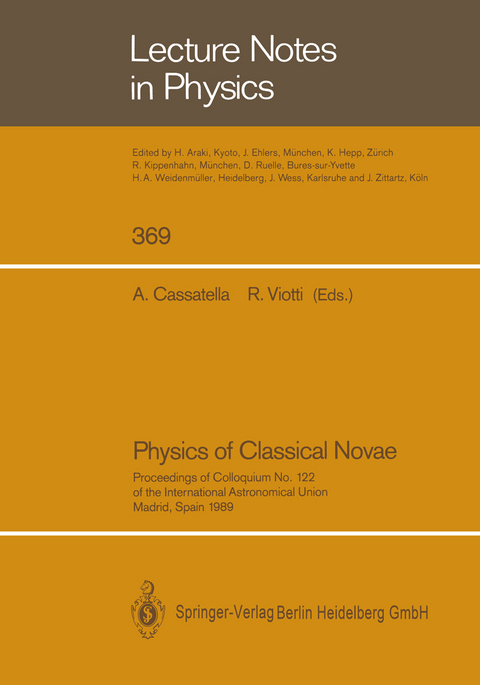
Physics of Classical Novae
Springer Berlin (Verlag)
978-3-662-13829-8 (ISBN)
For the first time, in these proceedings, observations, models, and the theory of classical novae are discussed following some ten years of satellite observations in a broad range of spectra. This collection, very useful for students of astrophysics, is introduced by a review article on the subject and closes with a summary.
Welcome address.- Cataclysmic variables as binary stars: Then and now.- The long term behaviour of classical old novae.- Classical novae: Properties between outbursts.- Galactic distribution and outburst frequency of classical novae.- Novae in clusters and galaxies.- Strong magnetic fields in nova systems.- Quasi-periodic outburst activity of novae at minimum.- Spin period variations of the white dwarf in FO AQR/H2215-086.- The galactic nova rate.- A possible nova from the IRAS point source catalogue.- Where is nova 1437? - Surprises in the space density of cataclysmic variables.- On the postoutburst far ultraviolet declines of WZ sagittae and V1500 CYGNI.- Spectroscopic observations of the southern old novae CP PUP and V841 OPH.- CP puppis: Another V1500 Cyg?.- The uv luminosity of old novae.- V 1500 Cyg: Slow variability in post-nova stage.- Maximum magnitude vs. rate of decline for novae of the LMC.- On V603 Aql and magnetic novae.- Optical studies of classical novae in outburst.- Chemistry of nova envelopes.- Ultraviolet observations of classical novae in outburst.- Multi-wavelength observations of novae in outburst.- New infrared results for classical novae.- Recent and future x-ray observations of classical novae during the outburst stage.- New results about post optical maximum oscillations of novae.- Simultaneous optical and UV spectra of the two LMC novae 1988.- Optical spectrophotometry of nova PW vulpeculae.- The early outburst spectra of nova V1506 CYGNI.- Mass of the, ejected envelope of LV vulpeculae.- The peculiar slow nova X serpentis.- Images and light curves of the radio remnants of novae.- Optical imagery of nova remnants.- Physical properties and abundances of novae in the nebular phase.- An H? image of nova V1500 cygni twelve years afteroutburst.- PAH'S and silicate emission in nova cen 1986.- Mm CO observation of the old nova NQ Vul.- Nova Ophiuchi 1988: 0.9-1.35 ?m spectroscopy.- Measurements of outburst characteristics, temperatures, densities and abundances in the ejecta of Nova Muscae 1983.- Element abundances of nova PW vulpeculae.- Chemical composition of Nova Centauri 1986.- Ultraviolet spectroscopy of the shell of RR pic.- Infrared spectra of recent novae.- The ionization of novae ejecta.- Winds from disks.- Physics of mass ejection during nova outbursts.- Effects of the presence of supercritical winds.- Formation and evolution of dust in novae.- Model atmospheres for novae during the early stages.- The continuum spectra of accretion discs in novalike objects.- Infra-red emission from classical novae.- Cool envelopes of post-novae constraints on the decline of the white dwarf.- Chemical routes to dust formation in the ejecta of novae.- Modelling the common envelope phase in classical novae.- Ionization and temperature structure in nova shells.- Formation of the balmer line in the optically thick nova envelope.- HeI emission line formation in symbiotic stars and novae.- Soft x-ray emission from classical novae in outburst.- Classical novae in the context of the evolution of cataclysmic binaries.- The origin and evolution of novae.- Novae between outbursts.- The cyclic evolution of classical novae.- Thermonuclear runaway model.- Theoretical implications of nova abundances.- The theoretical frequency of classical nova outbursts as a function of white dwarf mass.- Accretion on CO white dwarfs. influence of the external burning shells on the evolution.- Effective growth rate of white dwarf mass in nova outbursts.- The white dwarf mass and orbital period distributions in zero-age cataclysmicvariables.- Diffusion in novae at high accretion rates.- On the nature of the outflow from nova stars occurring immediately after ejection of an envelope.- Novae as local thermonuclear runaways.- Recurrent novae.- The symbiotic novae.- Spectroscopic results of the recurrent nova RS Ophiuchi.- A spectroscopic survey of recurrent novae at minimum.- Possible x-ray flares in a recurrent nova.- The 1989 outburst of V404 cygni: A very unusual x-ray nova.- The structure of the envelopes of symbiotic novae.- HM Sge still evolving.- IR observations of the symbiotic nova HM sagittae.- The light curve of the symbiotic nova HM sagittae.- The nova type outburst of the symbiotic star AS 296.- Co-ordinated optical and radio observations of symbiotic stars.- High resolution spectroscopy of symbiotic stars.- Some comments on classical novae and related systems.
| Erscheint lt. Verlag | 17.4.2014 |
|---|---|
| Reihe/Serie | Lecture Notes in Physics |
| Zusatzinfo | XII, 464 p. 11 illus. |
| Verlagsort | Berlin |
| Sprache | englisch |
| Maße | 170 x 244 mm |
| Gewicht | 782 g |
| Themenwelt | Naturwissenschaften ► Geowissenschaften ► Geophysik |
| Naturwissenschaften ► Physik / Astronomie ► Astronomie / Astrophysik | |
| Schlagworte | Accretion • Astronomie • Astronomy • astrophysics • Astrophysik • Common Envelope • Galaxy • LOPES • Optik • Photometry • Spectra • spectroscopy • Star • Variation • White Dwarf |
| ISBN-10 | 3-662-13829-8 / 3662138298 |
| ISBN-13 | 978-3-662-13829-8 / 9783662138298 |
| Zustand | Neuware |
| Haben Sie eine Frage zum Produkt? |
aus dem Bereich


